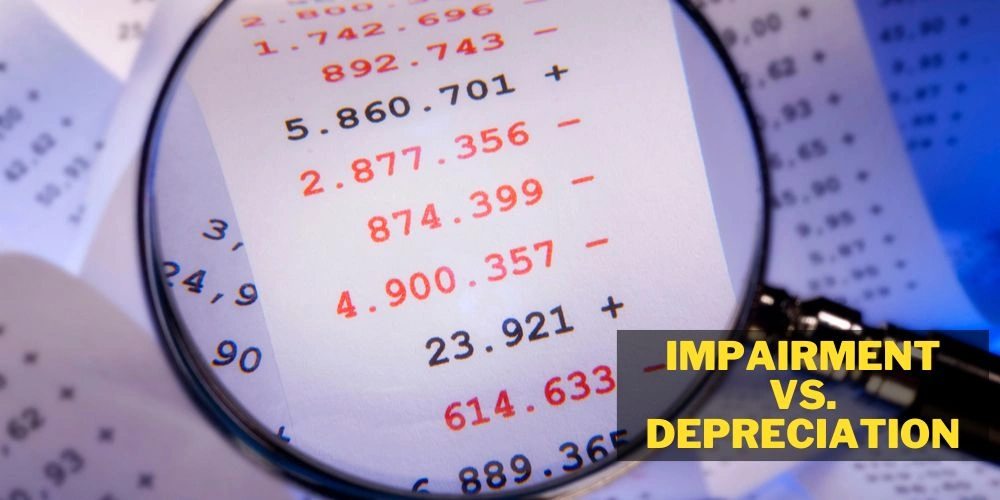When managing assets, businesses must understand two crucial concepts: Impairment vs Depreciation.
Both refer to a reduction in asset value, but they occur under different circumstances. Knowing when to apply each one is essential for accurate financial reporting and decision-making.
Understanding Depreciation
Depreciation refers to the reduction in the value of a tangible fixed asset over time. This reduction happens because of factors such as wear and tear, usage, or obsolescence.
Depreciation is a planned and systematic process, as businesses expect assets to lose value gradually.
There are several methods for calculating depreciation. The straight-line method is the simplest and spreads the cost evenly over the asset’s useful life.
The declining balance method accelerates depreciation, meaning the asset loses more value in the earlier years.
The units of production method ties depreciation to the actual use of the asset, meaning depreciation varies based on how much the asset is used.
Depreciation is used for assets like buildings, machinery, and vehicles that have a clear useful life. It allows businesses to account for the ongoing cost of asset usage over time.
Understanding Impairment
Impairment, on the other hand, is the sudden and often significant reduction in the value of an asset. Unlike depreciation, impairment is not a gradual process. It usually occurs due to external factors, such as damage to the asset or changes in the market or economy.

For example, if a building is severely damaged in a natural disaster, its value may drop quickly and significantly. In this case, impairment would be recognized, reducing the asset’s value on the balance sheet. The company would then write down the asset to reflect its new value.
Impairment can apply to both tangible and intangible assets. Unlike depreciation, impairment losses can sometimes be reversed if the asset’s value recovers later on.
This is why businesses need to regularly assess the value of their assets.
Impairment Vs Depreciation
While both depreciation and impairment involve a loss of value, the key difference lies in how they are applied.
Depreciation is a routine, ongoing process. It happens over time and is based on the asset’s expected useful life. Impairment, however, is an unexpected event that occurs when an asset’s value suddenly drops due to factors outside normal wear and tear.
Another difference is in their treatment on financial statements. Depreciation is recognized as an expense on the income statement and reduces taxable income over time. Impairment, on the other hand, is usually recorded as a loss on the balance sheet, reducing the asset’s carrying amount.
Also, while depreciation is irreversible, impairment can sometimes be reversed. If conditions improve, the value of the impaired asset may recover, and the impairment loss can be adjusted.
When and Why to Use Impairment vs. Depreciation?
Depreciation applies to assets that have a predictable lifespan and are expected to lose value steadily.
This includes things like machinery, vehicles, and office equipment. By recognizing depreciation, businesses can spread the cost of these assets over time, reducing their tax liability and reflecting the ongoing wear and tear.

Impairment, however, is used when there is an unexpected, significant reduction in the value of an asset. This can happen due to damage, obsolescence, or market changes.
Businesses must test their assets for impairment whenever there are signs that an asset may have lost value, such as after a natural disaster or an economic downturn.
Case Studies and Examples
For example, a business buys a piece of machinery for $100,000 and expects it to last for ten years. Using the straight-line depreciation method, the company records an annual depreciation expense of $10,000. This is a predictable, systematic reduction in the asset’s value.
In contrast, if the machinery is damaged in a fire, the company must assess the impairment. If the machine’s market value has dropped to $40,000, the company would recognize an impairment loss of $60,000, which reflects the sudden and significant loss in value.
Implications of Impairment and Depreciation for Businesses
Both impairment and depreciation have implications for a company’s financial statements. Depreciation reduces taxable income over time, which can provide tax benefits.
It also ensures that businesses account for the ongoing wear and tear on their assets.
Impairment, however, can lead to a larger, one-time loss, which might negatively affect profitability for the period in which the impairment is recognized.
Properly managing these two processes is crucial for accurate financial reporting.
Businesses should regularly assess their assets to determine whether they are being depreciated appropriately or if they need to recognize impairment.
Conclusion
Understanding the difference between impairment and depreciation is essential for managing assets effectively.
Depreciation is a gradual process tied to an asset’s expected life, while impairment is a sudden loss in value due to external factors.
By recognizing and applying both concepts correctly, businesses can maintain accurate financial records and ensure that their assets are appropriately valued.


 Tags:
Tags:










